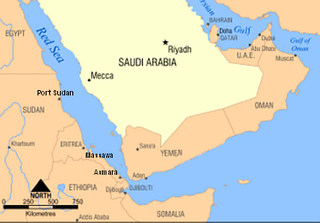
The British Mediterranean Fleet, also known as the Mediterranean Station, was a formation of the Royal Navy. The Fleet was one of the most prestigious commands in the navy for the majority of its history, defending the vital sea link between the United Kingdom and the majority of the British Empire in the Eastern Hemisphere. The first Commander-in-Chief for the Mediterranean Fleet was the appointment of General at Sea Robert Blake in September 1654. The Fleet was in existence until 1967.

The East Indies Station was a formation and command of the British Royal Navy. Created in 1744 by the Admiralty, it was under the command of the Commander-in-Chief, East Indies.

The Red Sea Flotilla was part of the Regia Marina Italia based at Massawa in the colony of Italian Eritrea, part of Italian East Africa. In World War II, the Red Sea Flotilla was active against the East Indies Station of the Royal Navy, from the Italian declaration of war on 10 June 1940 until the fall of Massawa on 8 April 1941.
HMS Khartoum was a K-class destroyer of the Royal Navy, named after the capital of Sudan, Khartoum.

The Eastern Fleet, later called the East Indies Fleet, was a fleet of the Royal Navy which existed between 1941 and 1952.

HMS Shoreham was the lead ship of the Shoreham-class of sloops built for the British Royal Navy. Completed in 1931, Shoreham served pre-war in the Persian Gulf. In the Second World War she served in the Gulf and Red Sea, the Mediterranean and the Indian Ocean. She survived the war and was sold for commercial use in 1946 and was scrapped in 1950.
The Commodore-in-Charge, Algiers was an administrative shore based appointment of the British Royal Navy established during World war II who was responsible for the berthing of all British convoys in Algeria and its sub-commands, facilities and staff from 1942 to 1946. The post holder was based at Allied Force Headquarters, Algiers. It was at first a sub-command of the Commander-in-Chief, Mediterranean Fleet then later the Commander-in-Chief, Levant.

The Rear-Admiral, Alexandria was a administrative shore based appointment of the British Royal Navy. The post was established during the Second World War, subordinate to the Commander-in-Chief, Mediterranean Fleet then later the Commander-in-Chief, Levant.
The Flag Officer, Middle East was a command appointment of the Royal Navy, established for two distinct periods from 1946–58 and then from c. 1962–1967. From c. 1946–1958 the appointment was located in the Suez Canal Zone or, after the Suez Crisis, in the Cyprus area; when reestablished from the post of Flag Officer, Arabian Seas and Persian Gulf, the focus was on the other side of Arabia. The headquarters moved from HMS Juffair in Bahrain to HMS Sheba, Steamer Point, Aden in 1962, and was located there until the British evacuation from Aden in 1967.
Brighlingsea Naval Base was an installation of the British Royal Navy located at Brightlingsea, Essex, on the East Coast of England. It was a sub-area command under the Commander-in-Chief, The Nore from 1914 to 1921 and again from 1939 to 1945.
The Flag Officer-in-Charge, Humber was the naval commander who administered the Humber Station also called the Humber Area a military formation of the Royal Navy located at Immingham and Grimsby, Lincolnshire, England. In World War I it was a sub-command of the Admiral of Patrols from 1914 to 1916, then came under the Commander-in-Chief at the Nore until 1921. In World War II the FOIC was responsible to the Commander-in-Chief, The Nore.
The Senior Naval Officer, Persian Gulf was a Royal Navy command appointment who was responsible for administering the Persian Gulf Station military formation including its establishments and naval forces known as the Persian Gulf Squadron later called the Persian Gulf Division. Initially located at Basidu, Qishm Island in Persia, then Henjam Island, Persia, (1911–1935) and finally Ras Al-Jufair, Bahrain from 1935 to 1972.
The British 11th Destroyer Flotilla also known as the Eleventh Destroyer Flotilla was a naval formation of the Royal Navy from August 1915 to September 1945.
The British 12th Destroyer Flotilla also known as the Twelfth Destroyer Flotilla was a naval formation of the Royal Navy from November 1915 to March 1919 and again from September 1939 to 2 July 1943.
The14th Destroyer Flotilla also known as the Fourteenth Destroyer Flotilla was a naval formation of the British Royal Navy from April 1916 to 11 February 1919 and again from 1 June 1940 to January 1944.

The Naval Officer-in-Charge, Aden was an administrative appointment of British Royal Navy originally established in 1839 as the Senior Naval Officer, Aden. He was responsible for HMS Sheba. It was a sub-command of the Flag Officer, Middle East.
The Senior British Naval Officer, Suez Canal Area was an administrative appointment of the Royal Navy established during World war II who was responsible for the naval base HMS Stag at Ismailia, Egypt. The SBNO was subordinate to the East Indies Station from 1939 to 1941 then the Mediterranean Fleet until 1942.

The Black Sea and Caspian Squadron, also known as the Black Sea and Marmora Force and the Black Sea and Marmora Division, was a naval formation of the British Mediterranean Fleet from 1918 to 1919.
Murray Pipon was a Royal Navy officer who served in World War I and, after being recalled to active duty in 1940, World War II.






